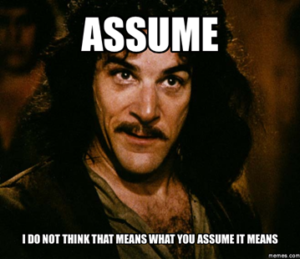I recently looked up the definition of “assume” on Dictionary.com (my favorite tool alongside Thesaurus.com when words are hard).
To assume means to: take for granted, accept without proof. 
Because I don’t want to assume everyone knows what it feels like or means to be taken for granted, I’ll share another quick definition.
To take for granted means to: underestimate the value of, fail to appreciate, become used to.
What stands out within those two definitions could be very different to everyone. But what stands out to me are proof and become used to.
Accepting Without Proof
It is so easy to put this sentence here, highlight that image there, add some pretty visual elements to give it pizzazz, and call it a day – all based on our gut because we’ve been there and done that (not to mention it’s been A WEEK). In other words, we check the boxes and get that piece of content, collateral, or message out, all without even proving if they work.
Rinse, recycle, repeat.
Becoming Used To
Over time, this tendency becomes even more of an issue and one that is harder and harder to break. Fast-forward a year or two and now you know your audience even better, you know your industry like the back of your hand, and you know how to crank out good work. You become used to your day-to-day, audience, and typical campaign patterns.
But did you really know your audience in the first place? What if they changed over time?
Do you understand not only what they expect from your brand, but what their motivations are? Why they do what they do? Why they use or not use your brand? What their hopes are for the future? Who they are as not only professionals, but people, and how that impacts their interaction with and affinity for your campaign or message?
Answers to all of these questions and more inform how to optimize interaction and enhance satisfaction, creating a gateway for you to meet your audience – who are people underneath it all – where they are, drive relevancy and context, and establish deeper connections and loyalty. This process and mindset enables the design of powerful experiences that are ever more important in a world where everyone is inundated by information and branding on a daily basis.
The Point
Without an approach that prioritizes audience needs and feedback, it is impossible to separate what we think they want from what they actually need.
To create experiences, and ultimately brands, that are useful, usable, findable, credible, desirable, accessible, and valuable, it is imperative to know what audiences think, when they think it, and why they think that. Otherwise, there is a high risk of seriously missing the mark and damaging brands, wasting campaigns, and falling short of goals.
Assuming makes a you-know-what out of U and Me.